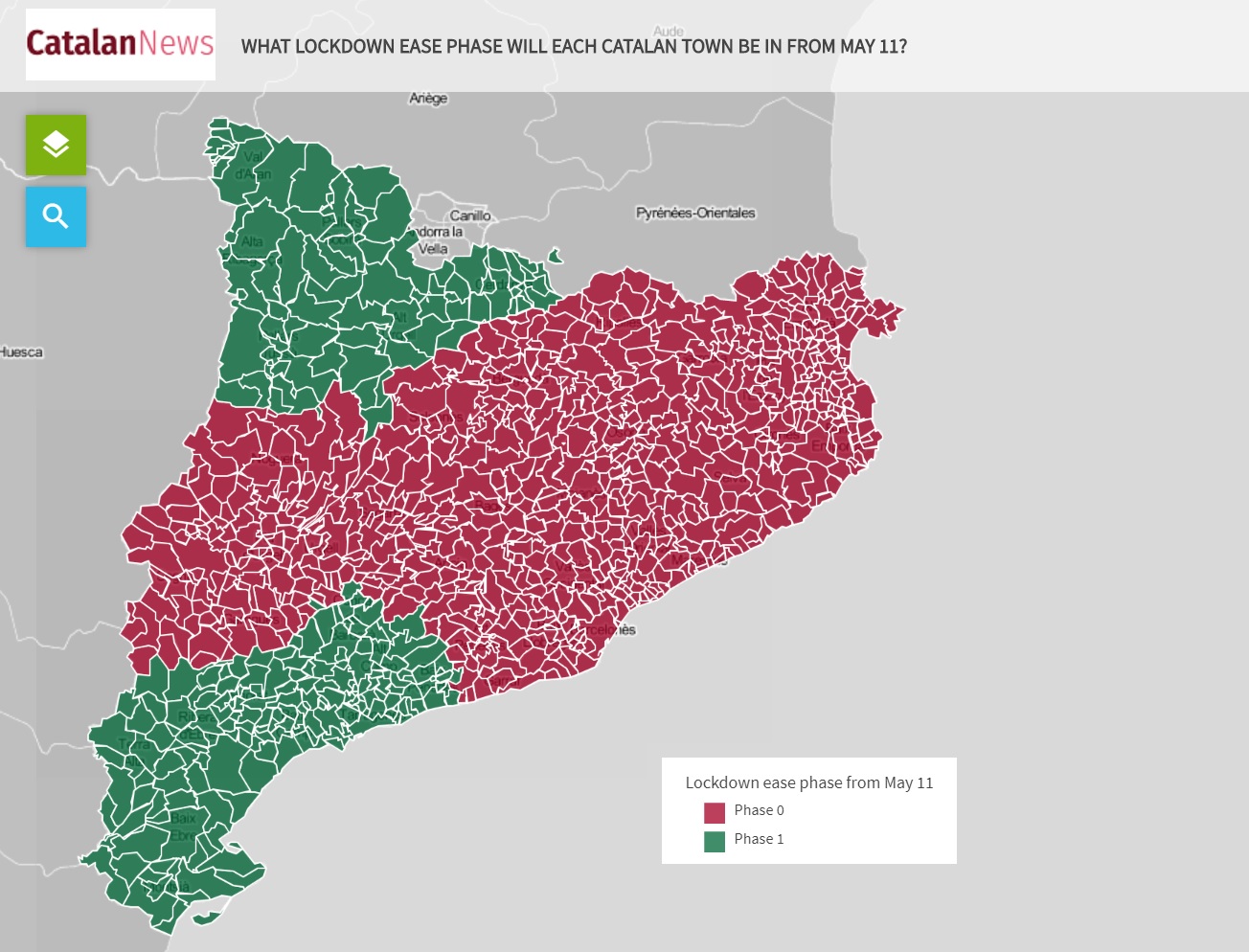Which towns will be in lockdown ease Phase 1 from May 11 and what is allowed?
Only 11% of population move to next stage; terraces, hotels and gatherings of up to 10 people will be permitted

Only 11% of Catalans have been allowed to move from May 11 to next stage of the de-escalation plan, Phase 1, that is, 861,597 people out of the 7.6 million inhabitants. The other roughly 90% of people will stay in Phase 0 for some more days, including cities such as Barcelona and its metro area, Girona and Lleida.
The Spanish health ministry accepted on Friday the Catalan government proposal of dividing Catalonia in health regions and not provinces, and also gave its go-ahead for only the western Pyrenees (Alt Pirineu i Aran), the Ebre river region (Terres de l’Ebre) and the Tarragona area (Camp de Tarragona) to move forward to the next phase. On Saturday, Madrid made public the specific rules of Phase 1, released through its official gazette (BOE).
Here’s an interactive map to check which municipalities will be through to Phase 1 and which will stay on Phase 0 on May 11.
Those towns staying in Phase 0 will see their limitations unchanged. Yet, the Catalan health minister, Alba Vergés, said in an interview with Diari Ara daily on Saturday that she will not wait two more weeks to request for Barcelona to move to Phase 1.
Activities allowed under Phase 1
During Phase 1, outside seating areas of bars and restaurants are allowed to open at 50% capacity (modified from the original 30%). Local councils have the power to grant more space to terraces then normal.
No more than 10 people will be able to sit at the same table in such terraces, and toilets of bars and restaurants will have to be disinfected at least six times per day, as revealed by Spain's official gazette (BOE) on Saturday, setting the rules for Phase 1.
Self-service elements such as cruet stands will not be allowed in bars and restaurants, and menus are not recommended; signs or boards should be prioritized.
Hotels and tourist accommodation can open during Phase 1 at their maximum capacity, that is, all of their rooms, but with restrictions and with communal areas remaining closed.
People will be able to leave their town and travel throughout the health region, but not go to another region (unless for health or work reasons). Going to their second home will be in the end allowed only if it is in the same region, after Spain's president, Pedro Sánchez, contradicted the BOE sooner after the detailed norms were published.
Set time slots are still in force, dividing the population by age groups and activity.
In general, shops can open during Phase 1 if they are under 400m2 by appointment only, so that does not include malls or shopping centers. Capacity is limited to 30% with a minimum distance of two meters between customers. Outdoor markets may open with council approval, and with restrictions. There are to be specific times especially for customers over 65.
During Phase 1 museums can open to 1/3 capacity, for visiting only, but not for other cultural activities. Cultural shows and events can take place with audiences of less than 30 indoors (at 1/3 capacity) and 200 outdoors (maintaining a suitable distance between people).
Libraries can open in Phase 1, for lending and reading rooms, and with limited capacity.
This stage also allows for socializing in small groups of up to 10 people among healthy people with no underlying conditions.
Individual sporting activities by appointment in sports centers such as gyms will also be permitted, as long as it does not involve physical contact or the use of changing rooms. Outdoor sports facilities can be used, but only for playing sports in which there is no contact (e.g. athletics, tennis).
Under Phase 1, the limitation of traveling by private vehicle is two people per row, except for people who live under the same roof, who could travel together with no limit.
This phase also includes the possibility of two people traveling by motorbike together without mask if they live together. If they don't, they will still be able to travel together, but with an obligatory mask or full-face helmet.
As for taxis and VTC services, it is still banned to sit in the co-pilot seat, and as for the rest of the seats, they can be full if occupants live under the same roof; otherwise, it's two per row.
Religious buildings will be able to open at a third of their capacity, with face masks recommended and prohibition to use holy water. Outdoor mourning will be allowed with a maximum of 15 people, and indoors with a maximum of 10 people.
Educational centers and universities will be able to open for administrative tasks, with congresses and scientific seminars of up to 30 people allowed - yet, students will not be able to return to classrooms until next school year.
At work, the BOE establishes that working from home has to still be allowed, and when not possible, workers have to respect a 2-meter safety one another. Companies have to avoid crowds introducing shifts, limiting the use of lifts to one person at a time, and paying special attention to beginnings and ends of shifts. No more than one person at a time will be able to use a toilet, which will have to be disinfected six times a day.